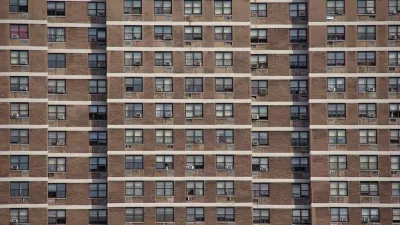For decades, the number of public housing units across the U.S. has been shrinking. But within the limits of the law and funding, HUD has figured out a way to get back some of the housing that has been lost.

In September 2008, Hurricane Ike swept through the Gulf Coast island community of Galveston, Texas, battering the city with 110 mph winds and storm surges that flooded the streets. Three of Galveston’s public housing projects were damaged beyond repair in the storm, resulting in the Galveston Housing Authority demolishing 569 apartments.
More than a decade later, the housing authority is still working to replace every unit that was lost. The agency was set to break ground on a final project in that effort in September. Ironically the ceremony was postponed because another storm, Hurricane Nicholas, was bearing down on the island. But once the project is complete, it will provide the final 174 units of deeply subsidized public housing that were lost to Ike, along with 87 units of moderately subsidized affordable housing and 87 units of market-rate housing.
The new apartments also hold the distinction of being the first in the country to use the U.S. Department of Housing and Urban Development’s (HUD) new Faircloth-to-RAD program, which was rolled out in April of this year in an effort to get public housing authorities the financing they need to build extremely low-income housing.
Combined with the Democrats’ proposal to include $80 billion in funding for public housing’s massive backlog of maintenance needs, there is new energy around public housing in the U.S. and potential for public housing production to get a much-needed boost.
New Public Housing?
Faircloth is a reference to the Faircloth Amendment, a 1998 Congressional amendment championed by North Carolina Sen. Lauch Faircloth that capped the number of public housing units the federal government was allowed to fund. It prohibited HUD from funding construction or operation of any new units beyond the number public housing authorities had in their stock as of Oct 1, 1999. The Faircloth Amendment was meant to bar the expansion of federal public housing. But thanks to decades of disinvestment ...
FULL STORY: New Public Housing? HUD Has Found a Way

Study: Maui’s Plan to Convert Vacation Rentals to Long-Term Housing Could Cause Nearly $1 Billion Economic Loss
The plan would reduce visitor accommodation by 25,% resulting in 1,900 jobs lost.

Alabama: Trump Terminates Settlements for Black Communities Harmed By Raw Sewage
Trump deemed the landmark civil rights agreement “illegal DEI and environmental justice policy.”

North Texas Transit Leaders Tout Benefits of TOD for Growing Region
At a summit focused on transit-oriented development, policymakers discussed how North Texas’ expanded light rail system can serve as a tool for economic growth.

Paris Bike Boom Leads to Steep Drop in Air Pollution
The French city’s air quality has improved dramatically in the past 20 years, coinciding with a growth in cycling.

Why Housing Costs More to Build in California Than in Texas
Hard costs like labor and materials combined with ‘soft’ costs such as permitting make building in the San Francisco Bay Area almost three times as costly as in Texas cities.

San Diego County Sees a Rise in Urban Coyotes
San Diego County experiences a rise in urban coyotes, as sightings become prevalent throughout its urban neighbourhoods and surrounding areas.
Urban Design for Planners 1: Software Tools
This six-course series explores essential urban design concepts using open source software and equips planners with the tools they need to participate fully in the urban design process.
Planning for Universal Design
Learn the tools for implementing Universal Design in planning regulations.
Smith Gee Studio
Alamo Area Metropolitan Planning Organization
City of Santa Clarita
Institute for Housing and Urban Development Studies (IHS)
City of Grandview
Harvard GSD Executive Education
Toledo-Lucas County Plan Commissions
Salt Lake City
NYU Wagner Graduate School of Public Service





























